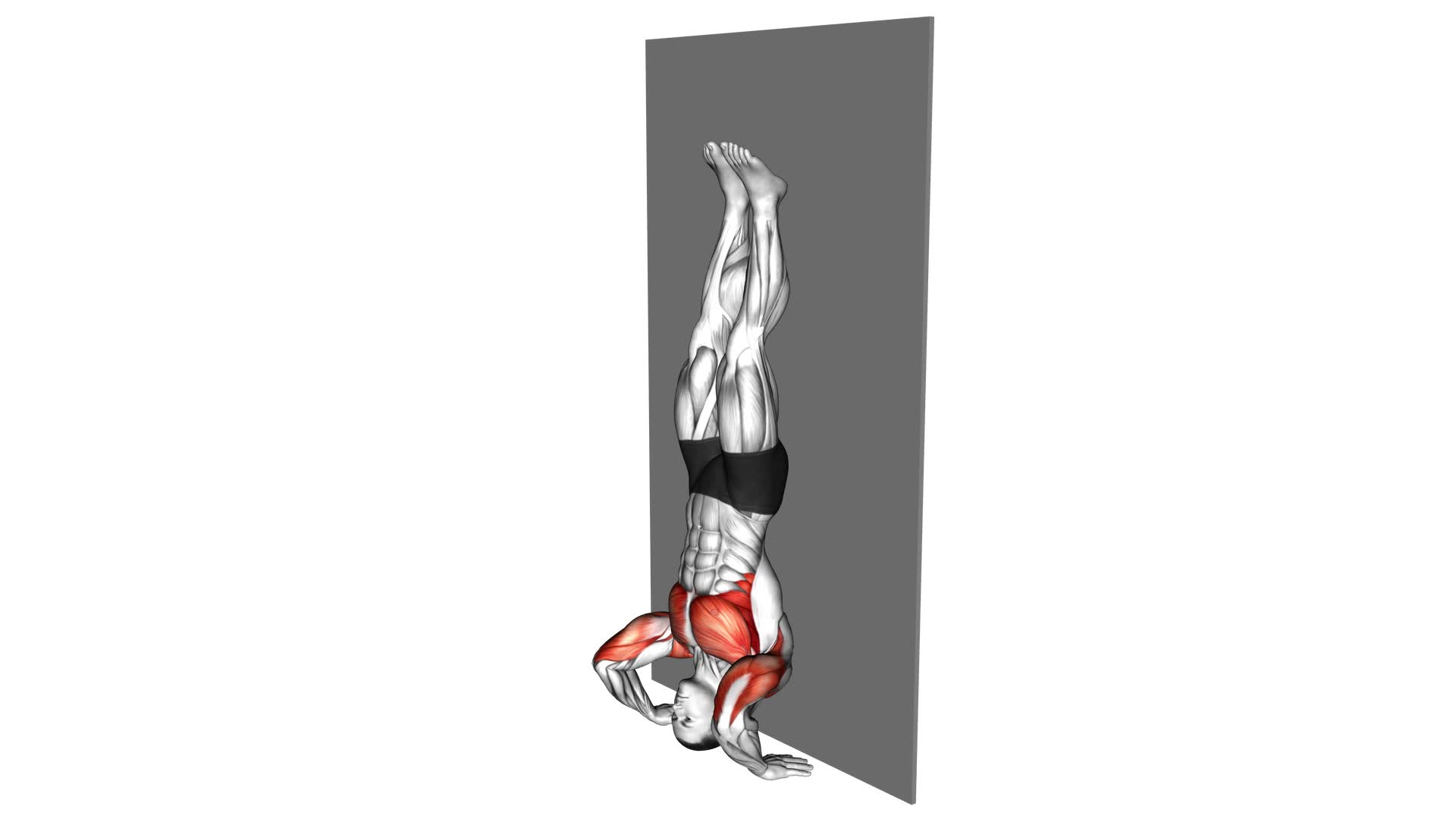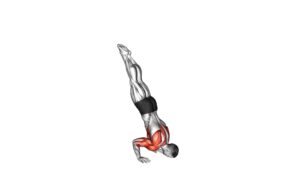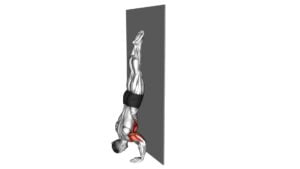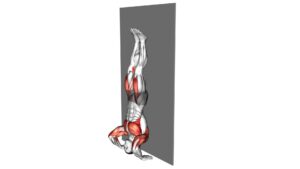Handstand Push-up (VERSION 2) – Video Exercise Guide & Tips

Looking to take your fitness routine to the next level? Get ready to challenge your upper body strength with the Handstand Push-up (Version 2).
Watch This Exercise Video
In this video exercise guide, we'll show you the proper form and technique, modifications and progressions, and common mistakes to avoid.
Plus, we'll share tips for building strength and stability to master this impressive move.
Get ready to elevate your fitness game and achieve new heights with the Handstand Push-up (Version 2)!
Key Takeaways
- Handstand Push-ups Version 2 strengthen the upper body and increase shoulder stability.
- The exercise targets the shoulders, triceps, and upper chest muscles.
- It improves muscular strength and endurance in the upper body.
- Handstand Push-ups Version 2 enhance overall shoulder strength and mobility.
Benefits of the Handstand Push-up (VERSION 2)
Experience the numerous benefits of the Handstand Push-up (VERSION 2) for a stronger upper body and increased shoulder stability. This advanced exercise isn't only challenging but also highly effective in targeting your shoulders, triceps, and upper chest muscles. By practicing Handstand Push-ups (VERSION 2), you can achieve greater muscular strength and endurance in your upper body.
One of the key benefits of this exercise is improved shoulder stability. As you perform Handstand Push-ups (VERSION 2), your shoulders are engaged in a highly demanding position, requiring them to work harder to maintain stability and control. This can help prevent shoulder injuries and enhance your overall shoulder strength and mobility.
Another benefit of Handstand Push-ups (VERSION 2) is that they can be easily progressed to suit your fitness level. Whether you're a beginner or an advanced athlete, you can modify the exercise by adjusting the range of motion, using assistance like resistance bands or a wall, or incorporating additional challenges like handstand push-ups on parallettes or with weighted vests.
Proper Form and Technique for the Handstand Push-Up (Version 2)
To properly perform the Handstand Push-Up (Version 2), you need to focus on maintaining proper form and technique. This exercise requires a good amount of upper body strength and stability, so it's important to follow the correct form to avoid injury and maximize the benefits.
Start by getting into a handstand position against a wall, with your hands shoulder-width apart and your body in a straight line. Engage your core and keep your legs straight and together. Slowly lower your body by bending your elbows, keeping them close to your sides. Lower until your head touches the ground or your hands are at 90-degree angles. Push back up to the starting position, fully extending your arms.
If you're just starting out or need to modify the exercise, there are handstand push-up progressions and modifications you can try. For beginners, you can start with pike push-ups, where you keep your legs bent and your body in an inverted V position. As you build strength, you can progress to full handstand push-ups.
Remember to always listen to your body and avoid overexertion. Proper form and technique are essential for getting the most out of the Handstand Push-Up (Version 2) and preventing any unnecessary strain or injury.
Modifications and Progressions for the Handstand Push-Up (Version 2)
Now let's explore the different options available to modify and progress the handstand push-up (Version 2).
If you're new to this exercise, there are scaling options tailored for beginners to gradually build strength and technique.
On the other hand, if you're more advanced, you can challenge yourself with advanced variations to take your handstand push-ups to the next level.
Lastly, we'll discuss common mistakes to avoid, ensuring you're performing this exercise safely and effectively.
Scaling Options for Beginners
Improve your strength and technique with beginner-friendly modifications and progressions for the Handstand Push-Up (Version 2).
If you're new to handstand push-ups or working towards building the necessary strength, there are scaling options available to help you progress safely and effectively.
One scaling option is to perform pike push-ups. In this variation, you position your body in a pike position and perform push-ups with your head lowered towards the ground. This modification allows you to build strength in your shoulders and upper body while still working on the pushing movement pattern.
Another option is to use a resistance band for assistance. By attaching a resistance band around your feet or hips and anchoring it to a stable object, you can reduce the amount of body weight you have to push up. This makes the exercise more manageable for beginners.
These scaling options provide a solid foundation for beginners to develop the necessary strength and technique for the Handstand Push-Up (Version 2).
Advanced Variations for Pros
If you're an advanced practitioner, you can challenge yourself further with modifications and progressions for the Handstand Push-Up (Version 2) by incorporating advanced variations. Here are some advanced progressions and techniques to try:
Advanced Progressions:
- One-Arm Handstand Push-Up: Perform a handstand push-up using only one arm while maintaining balance.
- Plyometric Handstand Push-Up: Add explosive power to your handstand push-up by pushing off the floor with force and quickly returning to the starting position.
Advanced Techniques:
- Deficit Handstand Push-Up: Place your hands on elevated surfaces to increase the range of motion and intensity.
- Freestanding Handstand Push-Up: Perform handstand push-ups without any support or wall assistance, relying solely on your strength and balance.
These advanced variations will push your limits and help you take your handstand push-up game to the next level. Remember to always prioritize proper form and gradually progress to more challenging variations.
Common Mistakes to Avoid
To maximize your performance and prevent injury, it's crucial to be aware of and avoid common mistakes when attempting modifications and progressions for the Handstand Push-Up (Version 2).
One common mistake isn't maintaining proper technique. It's important to keep your body aligned and straight throughout the movement, with your hands shoulder-width apart and your elbows pointing backward.
Another mistake is rushing through the exercise without proper control. Take your time and focus on maintaining a slow and controlled descent and ascent.
Additionally, avoid arching your back or letting your head drop forward during the exercise.
Common Mistakes to Avoid During the Handstand Push-Up (Version 2)
To perform the handstand push-up (Version 2) correctly, it's crucial that you avoid these common mistakes:
- Not using proper handstand push-up modifications: One of the most common errors isn't modifying the exercise to match your current fitness level. If you're new to handstand push-ups, start by practicing against a wall or using a resistance band for assistance. This will help you build strength and stability gradually.
- Performing the exercise with incorrect form: Another mistake isn't maintaining proper form during the movement. Make sure your body is in a straight line from your head to your toes, and your elbows are at a 90-degree angle at the bottom of the movement. Avoid arching your back or letting your head drop towards the ground.
By avoiding these common handstand push-up errors, you can perform the exercise safely and effectively.
Now let's move on to some tips for building strength and stability for the handstand push-up (Version 2).
Tips for Building Strength and Stability for the Handstand Push-Up (Version 2)
To build strength and stability for the handstand push-up (Version 2), focus on incorporating these tips into your training routine.
First, prioritize building a strong core. A strong core is essential for maintaining balance and control during the handstand push-up. Incorporate exercises such as planks, Russian twists, and leg raises to strengthen your abdominal and lower back muscles.
Next, progress through different handstand variations to gradually build up your strength and stability. Start with wall walks, where you walk your feet up a wall and hold a handstand position. As you become more comfortable, try practicing freestanding handstands against a wall for support. Eventually, work towards achieving a fully freestanding handstand.
In addition to core and handstand progression, it's important to work on your shoulder and upper body strength. Include exercises like push-ups, shoulder presses, and handstand holds to target these areas.
To ensure proper form and technique, seek guidance from a qualified trainer or coach. They can provide personalized feedback and help you progress safely.
Sample Workout Incorporating the Handstand Push-Up (Version 2)
For a well-rounded workout that incorporates the handstand push-up (Version 2), try the following sample routine:
- Warm-up:
- Start with 5-10 minutes of light cardio, such as jogging or jumping jacks, to get your blood flowing and your muscles warmed up.
- Follow with dynamic stretches, such as arm swings and shoulder circles, to loosen up your upper body.
- Strength Training:
- Perform 3 sets of 8-10 handstand push-ups (Version 2), focusing on maintaining proper form and engaging your core.
- Rest for 1-2 minutes between sets to allow for recovery.
- Compound Exercises:
- Incorporate compound exercises that target multiple muscle groups, such as push-ups, squats, and deadlifts, into your routine.
- Aim for 3 sets of 10-12 reps for each exercise, with a 1-2 minute rest between sets.
- Core Work:
- Include core exercises like planks, Russian twists, and bicycle crunches to strengthen your abdominal muscles.
- Perform 2-3 sets of 12-15 reps for each exercise, with minimal rest between sets.
- Cool-down:
- Finish your workout with 5-10 minutes of light stretching to promote flexibility and prevent muscle soreness.
This sample workout incorporates the handstand push-up (Version 2) while also building overall strength and targeting other muscle groups. Remember to adjust the intensity and repetitions based on your fitness level and gradually increase as you get stronger. Stay consistent and enjoy your journey to a stronger and more balanced physique.
Frequently Asked Questions
How Many Calories Does a Handstand Push-Up (Version 2) Burn?
Handstand push-ups (version 2) can be a great way to burn calories and activate your muscles. When performing this exercise, you engage several muscle groups, including your shoulders, triceps, and core. The more muscles you activate, the more calories you can potentially burn.
However, the exact number of calories burned during a handstand push-up (version 2) can vary depending on factors such as your body weight and intensity level. Regularly incorporating this exercise into your workout routine can help increase your calorie burn and muscle activation.
Can Handstand Push-Ups (Version 2) Help With Improving Shoulder Flexibility?
Handstand push-ups (version 2) can definitely help improve shoulder flexibility. By incorporating this exercise into your routine, you'll be able to strengthen your shoulders while also increasing their range of motion.
The benefits of handstand push-ups extend beyond just building strength – they also enhance your overall upper body stability and core strength.
Is It Safe to Perform Handstand Push-Ups (Version 2) if I Have a History of Shoulder Injuries?
If you have a history of shoulder injuries, it's important to proceed with caution when performing handstand push-ups (version 2). While this exercise can help improve shoulder flexibility, it may also put strain on your shoulders if not done correctly.
To prevent further injury, it's recommended to modify handstand push-ups by using a wall or a partner for support, or by decreasing the range of motion. Consulting with a qualified fitness professional can also help ensure proper form and shoulder injury prevention.
Can Handstand Push-Ups (Version 2) Be Included in a Beginner's Workout Routine?
Yes, handstand push-ups (version 2) can be included in a beginner's workout routine. They can be modified for beginners by starting with wall assisted handstand push-ups or pike push-ups.
To properly execute a handstand push-up (version 2), begin in a handstand position with your feet against a wall. Lower your body towards the ground by bending your elbows, then push back up to the starting position.
Remember to engage your core and maintain proper form throughout the exercise.
How Long Does It Typically Take to Progress From a Regular Push-Up to a Handstand Push-Up (Version 2)?
To progress from a regular push-up to a handstand push-up (version 2), the progression time may vary depending on your individual fitness level and dedication. However, with consistent practice and technique improvement, you can gradually build the strength and balance required for this advanced exercise.
It's important to focus on proper form and gradually increase the difficulty by incorporating progressions like pike push-ups and wall-assisted handstand push-ups.
Keep pushing yourself and you'll get there!
Conclusion
In conclusion, the handstand push-up (version 2) is a challenging exercise that offers numerous benefits for strength and stability.
By maintaining proper form and technique, avoiding common mistakes, and gradually progressing in difficulty, individuals can build the necessary strength to perform this exercise effectively.
Incorporating the handstand push-up (version 2) into a well-rounded workout routine can help improve upper body strength and overall fitness.

Author
Years ago, the spark of my life’s passion ignited in my mind the moment I stepped into the local gym for the first time. The inaugural bead of perspiration, the initial endeavor, the very first surge of endorphins, and a sense of pride that washed over me post-workout marked the beginning of my deep-seated interest in strength sports, fitness, and sports nutrition. This very curiosity blossomed rapidly into a profound fascination, propelling me to earn a Master’s degree in Physical Education from the Academy of Physical Education in Krakow, followed by a Sports Manager diploma from the Jagiellonian University. My journey of growth led me to gain more specialized qualifications, such as being a certified personal trainer with a focus on sports dietetics, a lifeguard, and an instructor for wellness and corrective gymnastics. Theoretical knowledge paired seamlessly with practical experience, reinforcing my belief that the transformation of individuals under my guidance was also a reflection of my personal growth. This belief holds true even today. Each day, I strive to push the boundaries and explore new realms. These realms gently elevate me to greater heights. The unique combination of passion for my field and the continuous quest for growth fuels my drive to break new ground.







